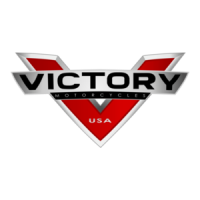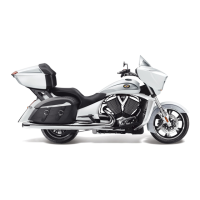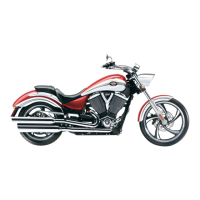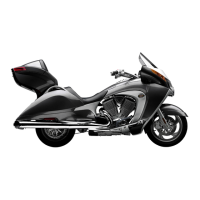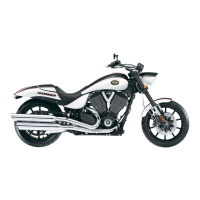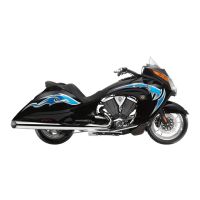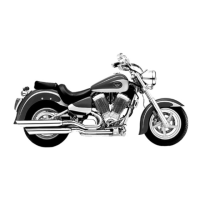
Do you have a question about the Victory Motorcycles Classic Cruiser 2003 and is the answer not in the manual?
| Brand | Victory Motorcycles |
|---|---|
| Model | Classic Cruiser 2003 |
| Category | Motorcycle |
| Language | English |
Guidance on reading the manual for safe riding and proper maintenance of the motorcycle.
Explanation of safety signal words and symbols for user comprehension.
Essential practices for safe motorcycle operation, including rider education and manual adherence.
Instructions for safely carrying a passenger, including proper seating and handling adjustments.
Recommendations for protective gear to decrease injury risk and increase riding comfort.
Information on the motorcycle's weight capacity and its impact on stability and handling.
Guidelines for attaching cargo and accessories to minimize instability and loss of control.
Operating guidelines and load capacity for motorcycles equipped with saddlebags.
Procedures for safely parking the motorcycle, including steering lock and surface considerations.
Guidelines for choosing and installing accessories to maintain motorcycle stability and operation.
Precautions for safe fueling and awareness of exhaust gas hazards.
Identifies the locations of critical safety and vehicle information labels on the Classic Cruiser.
Identifies the locations of critical safety and vehicle information labels on the Touring Cruiser.
Procedure for reporting vehicle defects that could cause crashes or injuries to authorities.
Identification of major components located on the motorcycle's handlebars.
Identification of key components specific to the Classic Cruiser model.
Identification of key components specific to the Touring Cruiser model.
Details on the VIN's location and its importance for registration and parts ordering.
Information on the engine identification number's location and its use for registration.
Details on the ignition key number's location and its role in obtaining replacement keys.
Operation of the ignition key for starting, locking steering, and accessing latches.
Functions of the ignition switch for starting, lighting, and releasing the operator's seat.
Location and use of helmet holders on the Classic Cruiser model.
Description of the instrument cluster components: speedometer, tachometer, and indicators.
Explanation of various indicator lights such as oil pressure, fuel, and neutral.
Features and functions of the MFD, including odometer, clock, and gauges.
Operation of controls on the left handlebar, including fast idle and turn signals.
Operation of controls on the right handlebar, including engine stop/run and starter.
Procedure for operating the gear shift pedal for shifting gears up or down.
Operation of the rear brake pedal for engaging the rear brake.
Instructions for proper tightening and use of the fuel cap.
Operation of the auxiliary light switch on Touring Cruiser models.
Information on leather and hard saddlebags, including load capacity and operation.
Accessing components via side covers and operating the motorcycle's sidestand.
Procedure to verify the proper functioning of all motorcycle electrical systems.
Instructions for checking the engine oil level using the dipstick and oil fill cap.
Inspection of fuel level, hoses, rail, connections, and evaporative system.
Procedures for checking tire pressure, condition, and tread depth before riding.
Verification of front and rear brake lever/pedal movement and fluid levels.
Inspection of clutch lever and fast idle lever freeplay and operation.
Inspection of front suspension operation and steering smoothness and tightness.
Inspection of rear suspension adjustment and drive belt condition and tension.
Inspection of sidestand condition and attachment, and all motorcycle fasteners.
Special wear-in procedures for critical engine parts during the first 500 miles.
Instructions for fueling the motorcycle and setting the correct fuel tank fill height.
Step-by-step procedure for starting the motorcycle's engine.
Proper procedures for shifting gears using the five-speed transmission.
Techniques for accelerating the motorcycle smoothly and safely.
Guidelines for applying front and rear brakes evenly for effective slowing and stopping.
Procedure for safely stopping the motorcycle's engine and ignition.
Instructions for parking the motorcycle securely on various surfaces.
Recommended initial service after 500 miles for optimal performance and durability.
Table outlining recommended maintenance schedules for various motorcycle components.
Procedures for changing engine oil and oil filter, and checking oil level.
Instructions for inspecting and cleaning the motorcycle's air filter element.
Procedure for inspecting the drive sprocket and nut for wear or damage.
Checking drive belt condition and tension, and adjusting belt tension.
Procedure for aligning the rear wheel using specialized tools for proper tracking.
Adjusting the rear shock absorber preload for optimal suspension performance.
Checking front forks, seals, steering head bearings, and front axle.
Inspection and maintenance of fuel hoses, rail, connections, and fuel tank.
Checking and adjusting the fast idle lever and its cable freeplay.
Checking and adjusting the throttle control grip and cable freeplay.
Checking and adjusting clutch lever and cable freeplay, and lubricating the lever.
Checking and adding brake fluid, adjusting pedal freeplay, and checking pads/hoses.
Procedure for adjusting the gear shift pedal height.
Checking tire pressure, condition, tread depth, and wheel spokes.
Instructions for inspecting, cleaning, and replacing spark plugs.
Procedure for checking engine compression to assess wear and condition.
Inspection of the exhaust system for leaks and tightening of fasteners.
Instructions for removing and reinstalling the operator and passenger seats.
Information on battery care, removal, installation, and charging procedures.
Location and replacement procedure for motorcycle fuses.
Procedure for adjusting the motorcycle's headlamp aim.
Procedure for adjusting the aim of auxiliary lights on Touring Cruiser models.
Instructions for removing and installing leather and hard saddlebags.
Inspection of sidestand condition, pad wear, and lubrication of the pivot.
Visual inspection of all motorcycle chassis and engine fasteners for tightness.
Procedure for road testing the motorcycle after service to ensure proper operation.
Guidelines for regular cleaning to protect against corrosion and maintain appearance.
Instructions for washing and drying the motorcycle, avoiding high pressure water.
Procedures for waxing, polishing, and applying protectants to extend component life.
Instructions for cleaning the windshield and removing minor scratches.
Steps for cleaning and conditioning leather saddlebags to maintain their beauty.
Guidance on inspecting and repairing paint chips or scratches to prevent corrosion.
Choosing a suitable dry, well-ventilated location for motorcycle storage.
Preparing the motorcycle for storage by cleaning, waxing, and applying protectants.
Ensuring tires are inflated to normal pressure for storage.
Instructions for battery care during storage, including cleaning and charging.
Using fuel stabilizer and running the engine to protect the fuel system.
Protecting engine components during storage, including oil changes and spark plugs.
Steps to take when removing the motorcycle from storage before use.
Federal laws prohibiting tampering with motorcycle noise control systems.
Explanation of the emission control system warranty and coverage details.
Owner's responsibilities regarding maintenance and warranty coverage.
Limitations and exclusions that apply to the emission control system warranty.
Statement on Victory's limited liability concerning warranty claims and damages.
Details on the limited warranty policy, registration, and dealer set-up importance.
Technical specifications for the motorcycle's engine model, configuration, and performance.
Key physical dimensions of the Classic and Touring Cruiser models.
Dry and wet weight specifications, including Gross Vehicle Weight Rating (GVWR).
Specifications for engine oil and fuel tank capacities.
Details on the drive system, transmission, primary drive, and gear ratios.
Specifications for suspension, swingarm, front, and rear brakes.
Recommended fuel types, octane rating, and acceptable additives.
Recommended engine oil type and viscosity for optimal performance.
Information on how to purchase the official Victory Service Manual.
